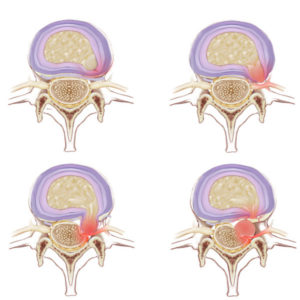To those who experience back pain after a long day’s worth of work or even a long flight that warrants copious amounts of sitting and spinal compression this is a good article for you. This article may explain why you’re experiencing that lower back pain.
What is it?
 The human spine is comprised of 23 segments: 6 in the neck, 12 in the mid-upper back (thoracic) and 5 in the lower back region (lumbar). Each vertebral segment is separated by a fibrocartilaginous disc. This disc is filled with a gel like substance that acts as a cushion for each segment. Prolonged and repetitive, or even abrupt stress may cause the intervertebral disc to bulge. Depending on the severity of the bulge, serious cases may be referred to as a “Lumbar Disc Lesion”, or in mild cases, an “Annular Strain”. Irrespective of the name, these pathologies may cause us to experience severe sharp shooting pain down our legs, weakness and localised lower back pain.
The human spine is comprised of 23 segments: 6 in the neck, 12 in the mid-upper back (thoracic) and 5 in the lower back region (lumbar). Each vertebral segment is separated by a fibrocartilaginous disc. This disc is filled with a gel like substance that acts as a cushion for each segment. Prolonged and repetitive, or even abrupt stress may cause the intervertebral disc to bulge. Depending on the severity of the bulge, serious cases may be referred to as a “Lumbar Disc Lesion”, or in mild cases, an “Annular Strain”. Irrespective of the name, these pathologies may cause us to experience severe sharp shooting pain down our legs, weakness and localised lower back pain.
The prevalence of disc herniation, annular fissure and disc degeneration in asymptomatic subjects were 81.4%, 76.1%, and 75.8% respectively (surveyed across South Korea population). This means that in a room of 10 people, 7 or 8 people will have a disc issue whether or not they present with symptoms. While some cases may present with no symptoms, it is advisable that the back is strengthened to make sure that these issues are maintained and do not continue to progress.
Signs and Symptoms
You may or may not experience all of these symptoms, but the following list involves a generalised list of what symptoms may present
– Localised lower back pain
– Referred band-like pain down buttocks and back of legs
– Neurological symptoms: tingling, numbness, shooting, electrical pain, weakness
– Pain on movement: bending forward, bending backwards and bending sideways
– Inability to perform normal activities pain free
-Bladder and Bowel changes (severe case)
Risk Factors
Risk factors are also characteristics that are screened for. Essentially risk factors are developed habits or attributes that make you more susceptible to the injury. If you have one of these risk factors, it does not guarantee that you will have this problem, however it indicates to us that you are at a higher risk of contracting this mechanical injury.
Common risk factors include:
– being Overweight
– Labour intensive occupations
– Hereditary
– Pregnancy
– Sedentary lifestyle
– Poor posture
– Aging
– Secondary spinal pathology
Some of these risk factors should and can be addressed through physiotherapy services.
Solution
All mechanical disc problems and lesions present differently and will require careful attention to understand the cause of the issue. However a general consensus solution includes:
– Education regarding nature of injury
– Education regarding activity modification
– Acute management of the injury
– Decompression of the lower back and re-introducing movement
– Progressive strengthening when appropriate.
Conclusion
It is important that professionals can help identify and treat any disc related injuries. By doing so, we would be able to fast track any recovery, but also educate and guide prophylactic treatment so that the injury does not get worse and does not reoccur.
